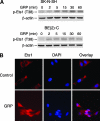Ets1 transcription factor mediates gastrin-releasing peptide-induced IL-8 regulation in neuroblastoma cells
- PMID: 17401458
- PMCID: PMC1838576
- DOI: 10.1593/neo.06841
Ets1 transcription factor mediates gastrin-releasing peptide-induced IL-8 regulation in neuroblastoma cells
Abstract
Angiogenesis plays a critical role in tumor progression in various cancers, including neuroblastoma. We have previously shown that gastrin-releasing peptide (GRP) stimulates neuroblastoma growth and that its cell surface receptors, gastrin-releasing peptide receptors (GRP-R), are overexpressed in advanced-stage human neuroblastomas; however, the effects of GRP on angiogenesis are not clearly elucidated. Interleukin (IL) 8, a proinflammatory chemokine, plays an important role during tumor angiogenesis. Ets transcription factors, such as oncoproteins, cause tumor development and are also known to induce IL-8 expression. In the present study, we found an increased expression of Ets1 in more undifferentiated human neuroblastomas. Stable transfection of SK-N-SH human neuroblastoma cells with Ets1 plasmid resulted in increased IL-8 luciferase activity and IL-8 secretion into cell culture media. Conversely, silencing of Ets1 resulted in a significant decrease in IL-8 secretion in SK-N-SH cells. Moreover, exogenous GRP treatment increased Ets1 (T38) phosphorylation and Ets1 nuclear accumulation, and enhanced Ets1 binding to its DNA consensus sequence, resulting in the stimulation of IL-8 mRNA expression and protein secretion. Our findings demonstrate that GRP upregulates proangiogenic IL-8 expression in an Ets1-dependent manner, suggesting a critical role of this process during GRP-induced neuroblastoma angiogenesis and metastasis.
Figures





Similar articles
-
Gastrin-releasing peptide-induced down-regulation of tumor suppressor protein PTEN (phosphatase and tensin homolog deleted on chromosome ten) in neuroblastomas.Ann Surg. 2005 May;241(5):684-91; discussion 691-2. doi: 10.1097/01.sla.0000161173.47717.71. Ann Surg. 2005. PMID: 15849504 Free PMC article.
-
Gastrin-releasing peptide is a growth factor for human neuroblastomas.Ann Surg. 2002 May;235(5):621-9; discussion 629-30. doi: 10.1097/00000658-200205000-00003. Ann Surg. 2002. PMID: 11981207 Free PMC article.
-
Hepatocyte growth factor-mediated gastrin-releasing peptide induces IL-8 expression through Ets-1 in gastric cancer cells.Oncol Res. 2013;20(9):393-402. doi: 10.3727/096504013X13657689382770. Oncol Res. 2013. PMID: 23924923
-
Role of gastrointestinal hormones in neuroblastoma.World J Surg. 2005 Mar;29(3):281-6. doi: 10.1007/s00268-004-7815-4. World J Surg. 2005. PMID: 15706438 Review.
-
The role of the transcription factor Ets1 in carcinoma.Semin Cancer Biol. 2015 Dec;35:20-38. doi: 10.1016/j.semcancer.2015.09.010. Epub 2015 Sep 25. Semin Cancer Biol. 2015. PMID: 26392377 Review.
Cited by
-
Autophagy mediates paracrine regulation of vascular endothelial cells.Lab Invest. 2013 Jun;93(6):639-45. doi: 10.1038/labinvest.2013.57. Epub 2013 Apr 22. Lab Invest. 2013. PMID: 23608754 Free PMC article.
-
Paired tumor and normal whole genome sequencing of metastatic olfactory neuroblastoma.PLoS One. 2012;7(5):e37029. doi: 10.1371/journal.pone.0037029. Epub 2012 May 23. PLoS One. 2012. PMID: 22649506 Free PMC article.
-
The War on Cancer rages on.Neoplasia. 2009 Dec;11(12):1252-63. doi: 10.1593/neo.91866. Neoplasia. 2009. PMID: 20019833 Free PMC article.
-
The role of ets factors in tumor angiogenesis.J Oncol. 2010;2010:767384. doi: 10.1155/2010/767384. Epub 2010 May 4. J Oncol. 2010. PMID: 20454645 Free PMC article.
-
Protein Tyrosine Phosphatase SHP2 Controls Interleukin-8 Expression in Breast Cancer Cells.J Mammary Gland Biol Neoplasia. 2022 Jun;27(2):145-153. doi: 10.1007/s10911-022-09521-x. Epub 2022 Jun 23. J Mammary Gland Biol Neoplasia. 2022. PMID: 35739379 Free PMC article.
References
-
- Shusterman S, Maris JM. Prospects for therapeutic inhibition of neuroblastoma angiogenesis. Cancer Lett. 2005;228:171–179. - PubMed
-
- Ribatti D, Marimpietri D, Pastorino F, Brignole C, Nico B, Vacca A, Ponzoni M. Angiogenesis in neuroblastoma. Ann NY Acad Sci. 2004;1028:133–142. - PubMed
-
- Ribatti D, Ponzoni M. Antiangiogenic strategies in neuroblastoma. Cancer Treat Rev. 2005;31:27–34. - PubMed
-
- Ribatti D, Vacca A, Nico B, De Falco G, Giuseppe Montaldo P, Ponzoni M. Angiogenesis and anti-angiogenesis in neuroblastoma. Eur J Cancer. 2002;38:750–757. - PubMed
-
- Maris JM, Matthay KK. Molecular biology of neuroblastoma. J Clin Oncol. 1999;17:2264–2279. - PubMed
Publication types
MeSH terms
Substances
Grants and funding
LinkOut - more resources
Full Text Sources
Medical
Molecular Biology Databases
Miscellaneous
